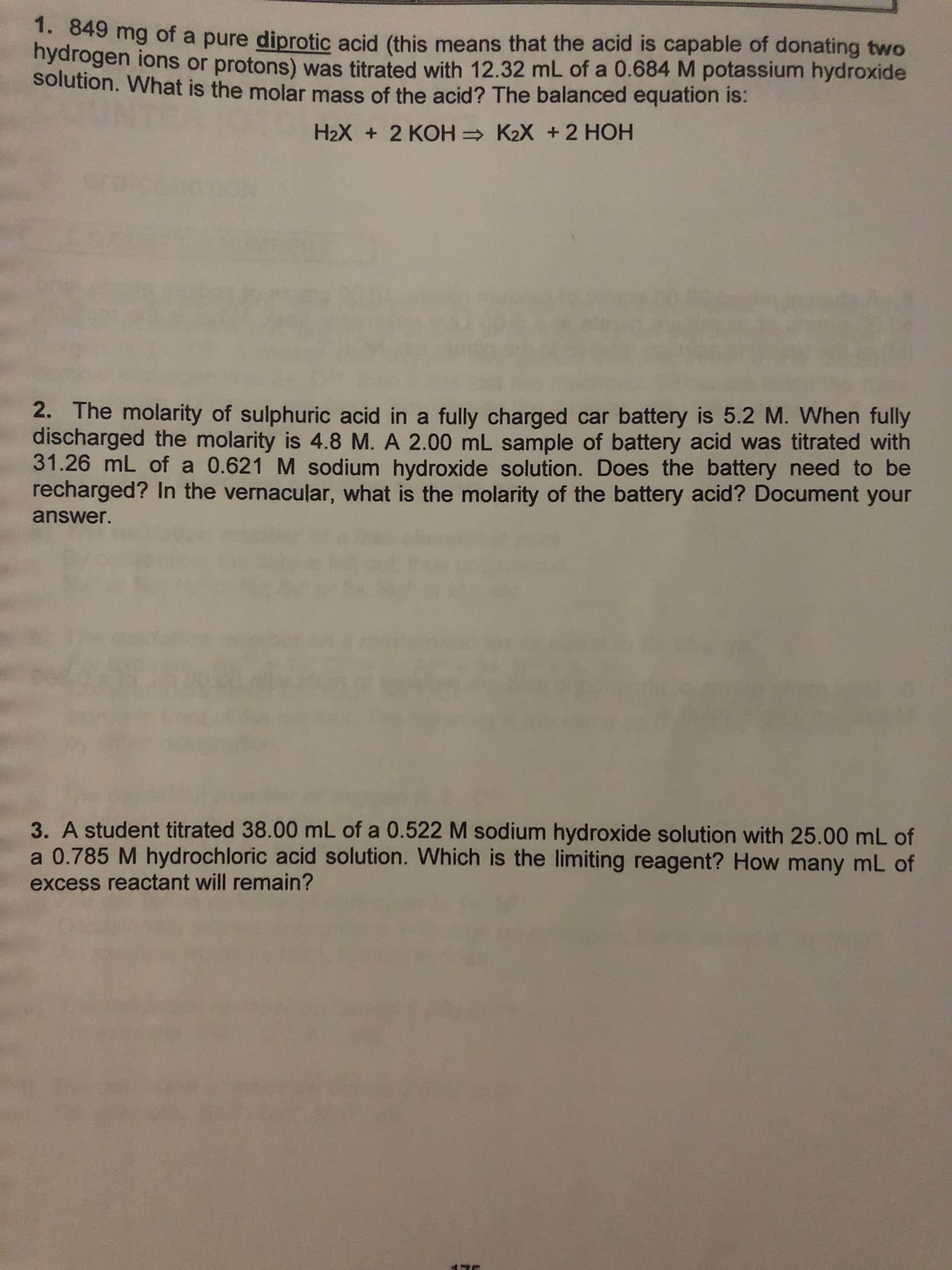1. 849 mg of a pure diprotic acid (this means that the acid is capable of donating two nydrogen ions or protons) was titrated with 12.32 mL of a 0.684 M potassium hydroxide solution. What is the molar mass of the acid? The balanced equation is: H2X 2 KOH K2X +2 HOH 2. The molarity of sulphuric acid in a fully charged car battery is 5.2 M. When fully discharged the molarity is 4.8 M. A 2.00 mL sample of battery acid was titrated with 31.26 mL of a 0.621 M sodium hydroxide solution. Does the battery need to be recharged? In the vernacular, what is the molarity of the battery acid? Document your answer. 3. A student titrated 38.00 mL of a 0.522 M sodium hydroxide solution with 25.00 mL of a 0.785 M hydrochloric acid solution. Which is the limiting reagent? How many mL of excess reactant will remain?
1. 849 mg of a pure diprotic acid (this means that the acid is capable of donating two nydrogen ions or protons) was titrated with 12.32 mL of a 0.684 M potassium hydroxide solution. What is the molar mass of the acid? The balanced equation is: H2X 2 KOH K2X +2 HOH 2. The molarity of sulphuric acid in a fully charged car battery is 5.2 M. When fully discharged the molarity is 4.8 M. A 2.00 mL sample of battery acid was titrated with 31.26 mL of a 0.621 M sodium hydroxide solution. Does the battery need to be recharged? In the vernacular, what is the molarity of the battery acid? Document your answer. 3. A student titrated 38.00 mL of a 0.522 M sodium hydroxide solution with 25.00 mL of a 0.785 M hydrochloric acid solution. Which is the limiting reagent? How many mL of excess reactant will remain?
Chapter9: Acids, Bases, And Salts
Section: Chapter Questions
Problem 9.102E
Related questions
Question
Question 2

Transcribed Image Text:1. 849 mg of a pure diprotic acid (this means that the acid is capable of donating two
nydrogen ions or protons) was titrated with 12.32 mL of a 0.684 M potassium hydroxide
solution. What is the molar mass of the acid? The balanced equation is:
H2X 2 KOH
K2X +2 HOH
2. The molarity of sulphuric acid in a fully charged car battery is 5.2 M. When fully
discharged the molarity is 4.8 M. A 2.00 mL sample of battery acid was titrated with
31.26 mL of a 0.621 M sodium hydroxide solution. Does the battery need to be
recharged? In the vernacular, what is the molarity of the battery acid? Document your
answer.
3. A student titrated 38.00 mL of a 0.522 M sodium hydroxide solution with 25.00 mL of
a 0.785 M hydrochloric acid solution. Which is the limiting reagent? How many mL of
excess reactant will remain?
Expert Solution
This question has been solved!
Explore an expertly crafted, step-by-step solution for a thorough understanding of key concepts.
This is a popular solution!
Trending now
This is a popular solution!
Step by step
Solved in 4 steps with 3 images

Knowledge Booster
Learn more about
Need a deep-dive on the concept behind this application? Look no further. Learn more about this topic, chemistry and related others by exploring similar questions and additional content below.Recommended textbooks for you


Chemistry: Principles and Practice
Chemistry
ISBN:
9780534420123
Author:
Daniel L. Reger, Scott R. Goode, David W. Ball, Edward Mercer
Publisher:
Cengage Learning

General Chemistry - Standalone book (MindTap Cour…
Chemistry
ISBN:
9781305580343
Author:
Steven D. Gammon, Ebbing, Darrell Ebbing, Steven D., Darrell; Gammon, Darrell Ebbing; Steven D. Gammon, Darrell D.; Gammon, Ebbing; Steven D. Gammon; Darrell
Publisher:
Cengage Learning


Chemistry: Principles and Practice
Chemistry
ISBN:
9780534420123
Author:
Daniel L. Reger, Scott R. Goode, David W. Ball, Edward Mercer
Publisher:
Cengage Learning

General Chemistry - Standalone book (MindTap Cour…
Chemistry
ISBN:
9781305580343
Author:
Steven D. Gammon, Ebbing, Darrell Ebbing, Steven D., Darrell; Gammon, Darrell Ebbing; Steven D. Gammon, Darrell D.; Gammon, Ebbing; Steven D. Gammon; Darrell
Publisher:
Cengage Learning

Introductory Chemistry: A Foundation
Chemistry
ISBN:
9781337399425
Author:
Steven S. Zumdahl, Donald J. DeCoste
Publisher:
Cengage Learning

Principles of Modern Chemistry
Chemistry
ISBN:
9781305079113
Author:
David W. Oxtoby, H. Pat Gillis, Laurie J. Butler
Publisher:
Cengage Learning

Chemistry & Chemical Reactivity
Chemistry
ISBN:
9781337399074
Author:
John C. Kotz, Paul M. Treichel, John Townsend, David Treichel
Publisher:
Cengage Learning